镉暴露对吉富罗非鱼幼鱼生化指标、抗氧化反应、炎症和抗应激反应的影响
IF 3.2
3区 医学
Q2 ENVIRONMENTAL SCIENCES
引用次数: 0
摘要
本研究探讨了镉(Cd2+)暴露对吉富罗非鱼幼鱼生化指标、抗氧化反应、非特异性免疫反应、炎症反应、抗应激反应及相关基因表达水平的影响。在4种不同Cd2+浓度(0、0.2、0.4和0.6 mg/L)的养殖水域中,培养4组幼鱼30 d。关键发现包括:与对照组(0 mg/L Cd2+)相比,镉胁迫显著影响罗非鱼幼鱼肝脏和血清生化指标(p < 0.05)。鱼鳃、肝脏和血清中过氧化氢酶(CAT)、超氧化物歧化酶(SOD)活性和总抗氧化能力(T-AOC)显著降低(p < 0.05),丙二醛(MDA)含量显著降低(p < 0.05)。肝脏中白细胞介素-10 (IL-10)、超音hedgehog基因(SHH)、细胞色素氧化酶1A (CYP1A)表达水平显著下调(p < 0.05),白细胞介素-1β (IL-1β)、肿瘤坏死因子α (TNFα)、干扰素γ (IFNγ)、白细胞介素-6 (IL-6)、白细胞介素-8 (IL-8)、转化生长因子β1 (TGF-β1)、金属硫蛋白(MT)、热休克蛋白70 (HSP70)表达水平显著上调(p < 0.05)。综上所述,养殖水体中镉浓度超过0.2 mg/L后,GIFT罗非鱼幼鱼的生化指标、抗氧化反应、非特异性免疫反应、炎症反应和抗应激反应均发生显著变化。这些发现表明,即使是亚致死Cd2+浓度(≥0.2 mg/L)也会对罗非鱼幼鱼的生理健康和生存造成重大风险。本文章由计算机程序翻译,如有差异,请以英文原文为准。
The Effects of Cadmium Exposure on Biochemical Indexes, Antioxidant Responses, Inflammation, and Anti-Stress Responses of Juvenile GIFT Tilapia (Oreochromis niloticus).
This study investigated the effects of cadmium (Cd2+) exposure on the biochemical indexes, antioxidant responses, non-specific immune responses, inflammatory responses, anti-stress responses, and related gene expression levels of juvenile GIFT tilapia (Oreochromis niloticus). Four groups of juveniles were cultured for 30 days in four aquaculture waters with different levels of Cd2+ concentrations (0, 0.2, 0.4, and 0.6 mg/L). Key findings include: In comparison to the control group (0 mg/L Cd2+), cadmium stress significantly impacted the liver and serum biochemical indices of juvenile tilapia (p < 0.05). The activities of catalase (CAT), superoxide dismutase (SOD), and total antioxidant capacity (T-AOC) in the gills, liver, and serum were significantly decreased (p < 0.05) and the contents of malondialdehyde (MDA) showed the opposite trend. The expression levels of interleukin-10 (IL-10), sonic hedgehog (SHH), and cytochrome oxidase 1A (CYP1A) were significantly down-regulated (p < 0.05) and the expression levels of interleukin-1β (IL-1β), tumor necrosis factor α (TNFα), interferon γ (IFNγ), interleukin-6 (IL-6), interleukin-8 (IL-8), transforming growth factor β1 (TGF-β1), metallothionein (MT), and heat shock protein 70 (HSP70) in the liver were significantly up-regulated (p < 0.05). In conclusion, the concentration of cadmium in aquaculture water exceeded 0.2 mg/L, and the biochemical indexes, antioxidant responses, non-specific immune responses, inflammatory responses, and anti-stress responses of juvenile GIFT tilapia were markedly altered. These findings highlight that even sub-lethal Cd2+ concentrations (≥ 0.2 mg/L) pose substantial risks to the physiological health and survival of juvenile tilapia.
求助全文
通过发布文献求助,成功后即可免费获取论文全文。
去求助
来源期刊

Environmental Toxicology
环境科学-毒理学
CiteScore
7.10
自引率
8.90%
发文量
261
审稿时长
4.5 months
期刊介绍:
The journal publishes in the areas of toxicity and toxicology of environmental pollutants in air, dust, sediment, soil and water, and natural toxins in the environment.Of particular interest are:
Toxic or biologically disruptive impacts of anthropogenic chemicals such as pharmaceuticals, industrial organics, agricultural chemicals, and by-products such as chlorinated compounds from water disinfection and waste incineration;
Natural toxins and their impacts;
Biotransformation and metabolism of toxigenic compounds, food chains for toxin accumulation or biodegradation;
Assays of toxicity, endocrine disruption, mutagenicity, carcinogenicity, ecosystem impact and health hazard;
Environmental and public health risk assessment, environmental guidelines, environmental policy for toxicants.
 求助内容:
求助内容: 应助结果提醒方式:
应助结果提醒方式:


